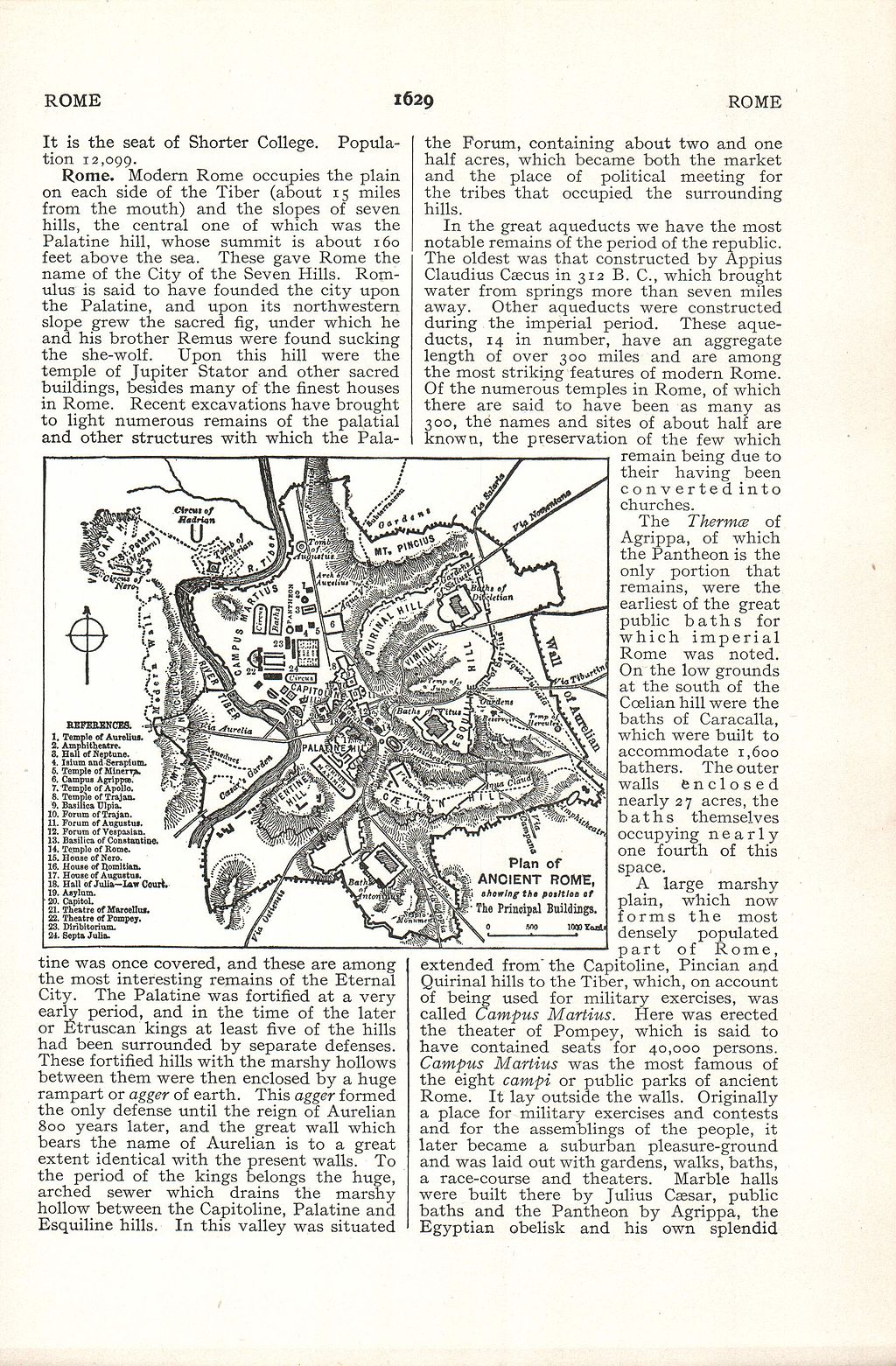Page 1629 : ROME — ROME
Individual articles:
It is the seat of Shorter College. Population 12,099.
Rome. Modern Rome occupies the plain on each side of the Tiber (about 15 miles from the mouth) and the slopes of seven hills, the central one of which was the Palatine hill, whose summit is about 160 feet above the sea. These gave Rome the name of the City of the Seven Hills. Romulus is said to have founded the city upon the Palatine, and upon its northwestern slope grew the sacred fig, under which he and his brother Remus were found sucking the she-wolf. Upon this hill were the temple of Jupiter Stator and other sacred buildings, besides many of the finest houses in Rome. Recent excavations have brought to light numerous remains of the palatial and other structures with which the Palatine was once covered, and these are among the most interesting remains of the Eternal City. The Palatine was fortified at a very early period, and in the time of the later or Etruscan kings at least five of the hills had been surrounded by separate defenses. These fortified hills with the marshy hollows between them were then enclosed by a huge rampart or agger of earth. This agger formed the only defense until the reign of Aurelian 800 years later, and the great wall which bears the name of Aurelian is to a great extent identical with the present walls. To the period of the kings belongs the huge, arched sewer which drains the marshy hollow between the Capitoline, Palatine and Esquiline hills. In this valley was situated the Forum, containing about two and one half acres, which became both the market and the place of political meeting for the tribes that occupied the surrounding hills.
In the great aqueducts we have the most notable remains of the period of the republic. The oldest was that constructed by Appius Claudius Caecus in 312 B. C., which brought water from springs more than seven miles away. Other aqueducts were constructed during the imperial period. These aqueducts, 14 in number, have an aggregate length of over 300 miles and are among the most striking features of modern Rome. Of the numerous temples in Rome, of which there are said to have been as many as 300, the names and sites of about half are known, the preservation of the few which remain being due to their having been converted into churches.
The Thermæ of Agrippa, of which the Pantheon is the only portion that remains, were the earliest of the great public baths for which imperial Rome was noted. On the low grounds at the south of the Cœlian hill were the baths of Caracalla, which were built to accommodate 1,600 bathers. The outer walls enclosed nearly 27 acres, the baths themselves occupying nearly one fourth of this space.
A large marshy plain, which now forms the most densely populated part of Rome, extended from the Capitoline, Pincian and Quirinal hills to the Tiber, which, on account of being used for military exercises, was called Campus Martius. Here was erected the theater of Pompey, which is said to have contained seats for 40,000 persons. Campus Martius was the most famous of the eight campi or public parks of ancient Rome. It lay outside the walls. Originally a place for military exercises and contests and for the assemblings of the people, it later became a suburban pleasure-ground and was laid out with gardens, walks, baths, a race-course and theaters. Marble halls were built there by Julius Cæsar, public baths and the Pantheon by Agrippa, the Egyptian obelisk and his own splendid
Image:
| Plan of ANCIENT ROME, showing the position of The Principal Buildings. |
REFERENCES.
- Temple of Aurelius.
- Amphitheatre.
- Hall of Neptune.
- Isium and Serapium.
- Temple of Minerva.
- Campus Agrippæ.
- Temple of Apollo.
- Temple of Trajan.
- Basilica Ulpia.
- Forum of Trajan.
- Forum of Augustus.
- Forum of Vespasian.
- Basilica of Constantine.
- Temple of Rome.
- House of Nero.
- House of Domitian,
- House of Augustus.
- Hall of Julia—Law Court.
- Asylum.
- Capitol.
- Theatre of Marcellus.
- Theatre of Pompey.
- Diribitormm.
- Septa Julia.
